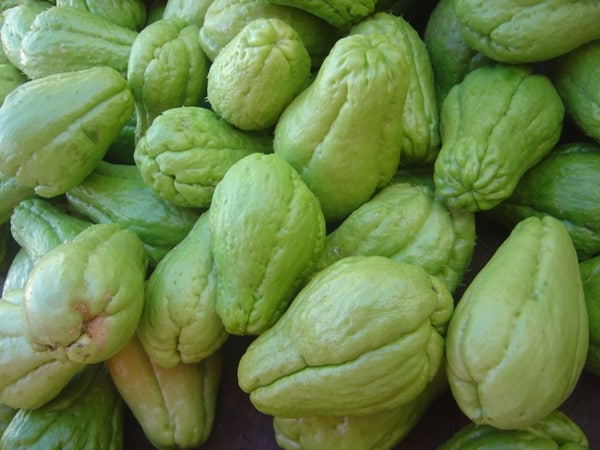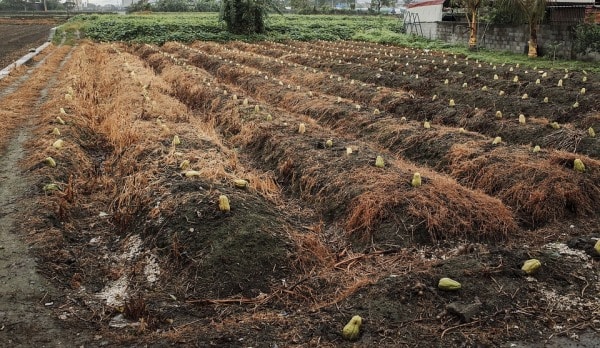Introduction to Growing Chayote Squash:
The following details are about Growing Chayote Squash / Chow Chow vegetable.
Among all the vegetables the Chayote is one of the oldest vegetable that has originated and is being cultivated. It is an edible vegetable. It belongs to the Cucurbitaceae family. The scientific name of Chayote is Sechiumedule. The Chayote is also known pear squash, christophine, pipinola, vegetable pear or cho-cho. By the 18th century, they were spread throughout the Caribbean and South America and then into Europe, Africa, Australia and Asia. The Chayote plant originated in Central America. It is a perennial vine. It is an annual plant whose natural habitat is in the temperate climates. It thrives very well in cool areas also. Each and every part of Chayote can be consumed. The chayot can be used for medical purposes also.
Characteristics of Chayote Squash:
- The vine of the Chayote plant reaches up to 30 feet in length; the structure of the stem is to get curled by the tendrils.
- The leaves are broad, shallow-lobed leaves which are 5-8 inches long.
- The flowers of the Chayote plant are small in size and the colour is light green.
- There are some differences in male and female flowers, male ones are pale yellow in colour and the female ones are greenish in colour. The flowers are non-productive.
- The fruit is 6 inches long, ridged, pear-shaped and colour of the Chayote is green.
- The seeds which are inside the fruit are flattened and smooth.

Properties of Chayote:
- The properties are measured for 100 grams of Chayote.
- The energy in Chayote is 19 kcal.
- In Chayote the carbohydrates present are 4.51 g.
- The fat content present is 0.13 g.
- The protein content in it is 0.82 g.
- The vitamins which are present in the Chayote are Vitamin B6, Vitamin C, Vitamin E and Vitamin K.
- Minerals which are present in Chayote are Zinc, Magnesium, Iron, Calcium, Potassium and Phosphorus.
Cultivars/Varieties in Growing Chayote Squash:
Chayote de Caballo:
- It closely relates to or looks like original Chayote.
- This variety comes under the wild variety of the Chayote.
- Sometimes it is smooth in texture.
- These can be stored for a long time.
- It can be hybridized with the common Chayote.
Chayotillo:
- It is a disease resistant variety and is also cross bred with the common Chayote.
- The genetic structure differs from the common Chayote.
- The hybridization is not possible in between other species.
Cabeza de Chango:
- It is an uncommon species.
- It grows in a small town of Oaxaca in Mexico.
- This variety slightly relates to the Chayote de caballo.
- The genetics are different from the common Chayote.
- It can’t tolerate high humidity.
- The hybridization of this variety is incompatible with common Chayote.
Soil and climate requirements for Growing Chayote Squash:
The soil for growing the Chayote should be well-draining. The soil which has more oolitic limestone can be used to produce better yield. The pH value of the soil should be 6.0-6.8 for Growing Chayote Squash plants. The Chayote is always referred to as a tropical plant, the plant of Chayote can thrive in the lowlands, but successful growth can be seen only in tropical areas. The temperature, which is required for the Chayote plant is 27˚C – 29˚C. The crop needs bright sunlight for growth.

Land preparation and planting for Growing Chayote Squash:
Before preparing the land the weeds and stones should be removed from the land. Land should be well prepared by mixing manure with soil. Shallow holes should be prepared of 1 sq. foot wide and the distance between the holes should be 3 m between hills and rows. Now the land should be supplied with the organic fertilizer to make the soil fertile. 3 fruit seeds should be sown in one hill, leaving 1/3 of the seed exposed. In rainy season the planting should be done so that much irrigation is not required.
Propagation method for Growing Chayote Squash:
The Chayote plant propagation is done by the seeds. The seeds generally germinate inside the fruit which is fully mature. Actually, it is customary to keep the fruit to sprout, but some people remove it to consume it as a fruit.
Manure and fertilization method in Growing Chayote Squash:
The organic fertilizer should be in the form of chicken manure or composted manure. While side dressing of the plant, basal fertilizer @ 3-5 tonnes per hectare should be applied. The triple 14 or triple 16 should be applied @ 2 sacks per hectare or as an alternative the organic fertilizers should be applied for good growth and development of the crop. The soil should also be raised to cover and to support the base of the plants and also to apply the fertilizer for them.
Irrigation methods in Growing Chayote Squash:
The Chayote plant requires more water. The planting should be done in such a place where the water is abundant and there is constant irrigation without any water problem. The plant should be facilitated in such a way that it should receive minimum 1000-2000 litres in a year. Incase of water-logging, there should be a facility for draining the water as soon as possible. The crop should be grown in rainy season so that there would be no problem for irrigation. While in the summer season, the amount of water should be irrigated is usally high.
Flowering and fruiting in Growing Chayote Squash:
The flowering and fruiting happens in a natural way. The fruits fall down when they are ripe and get completely rotten in some days. The seed of the fruit doesn’t develop roots and start germinating like other fruit crops. The fruit should be cut from the tree and the fruit should be kept in damp and dark place so as to develop new buds and new leaves from it.
The Chayote fruit has great ability of good germination and it start on its own without any particular place for germination. For example: If you leave the fruit in warm temperature, after few days it starts tendering the shoot and begins to grow. When the plant is ready the stem reaches 20-25 cm of its tendrils.
Intercultural methods in Growing Chayote Squash:
Weed control: Weed control in the field also helps in deterring other pests in the field. The below measures can be used for the weed control.
- Before planting seedlings to kill the emerging weeds we must use the pre-emergence herbicides.
- The grass which is around the crop should be killed, but it shouldn’t harm the crop. We should select the herbicides in that way.
- Crop rotation is also helpful.
- The weeds can also be removed manually.
- Before the plants start to spread use the contact herbicides if necessary.
De-leafing: We should remove all the old and dried leaves in every 3 months. This makes the tree produce young and active leaves which are helpful in plant growth, for light reception and good food production. The plants which are infected with diseases or any other virus should be removed.
Mulching: The plants which are unwanted are called weeds. Mulching the base of the plants can control weeds and retain soil moisture.
Trellising: The plant vine should be tied with thread so that the vine grows and the root development will also be good.
Pest and disease control measures in Growing Chayote Squash:
The pests infesting the Chayote plant are Plant Bug, Spider Mites and White flies.
Control measures for the pests:
- These should be controlled by using sprinkler irrigation to wet the plants.
- It can also be controlled by removing the damaged fruits.
- To decrease the white flies, leaves which are infested should be cut.
- The pests can be controlled by maintaining proper sanitation and weeding.
The diseases infecting the Chayote plant are mostly Viral in nature.
Control measures for the diseases:
- The diseases can be controlled by using disease free planting material.
- By removing the infected parts and plants around the plants also decreases the intensity of the disease.
- Proper hygiene and sanitation can also be helpful.
Harvesting techniques in Growing Chayote Squash:
The harvesting should be done once in a week. We should harvest the fruits which are smooth in texture and not fibrous. The harvesting should be done always early in the morning. So, that the morning temperatures will be low and the fruits will also be fresh.
Post harvesting techniques in Growing Chayote Squash:
Storing: After harvesting them. They should be cleaned and kept in a cold storage where the temperature is 9˚C – 12˚C and the humidity is maintained at 90% for 6 weeks before they show the symptoms of shrivelling. Further low temperatures may cause pitting and browning to the fruit.
Selection: The fruits should be harvested early in morning due to low temperatures, if not the fruits should be pre-cooled with water at 0˚C. Before storing them they will be graded according to their size, colour, appearance and health. The colour will be olive green and they appear smooth without the spines.
Packing: The fruits are individually packed in polyethylene bags, so that there is no accumulation of water vapour and fruit transpiration. While transporting them to the commercial markets they should be packed in boxes.
Yield in Growing Chayote Squash:
The number of fruits harvested per vine is 75-600 and it depends on the variety of the Chayote. The average yield of the Chayote in a hectare of land is 120,000 tonnes in a year.
By-products of Growing Chayote Squash:
Honey: The honey is one of the by-products which is extracted from the Chayote flowers. The female and male flowers are heavily visited by honey bees and they have 10 glands into which abundant amount of nectar can be stored and some people who know about this believe that it is one of the best honey extracted from the plants.
Fiber: The use of fiber is in cordage and in weaving. The fiber can be extracted from the old stems.
Vine: The vine of this crop is used for livestock grazing.
Read: SPIRULINA FARMING.
Read: DAIRY FARMING FAQ.
